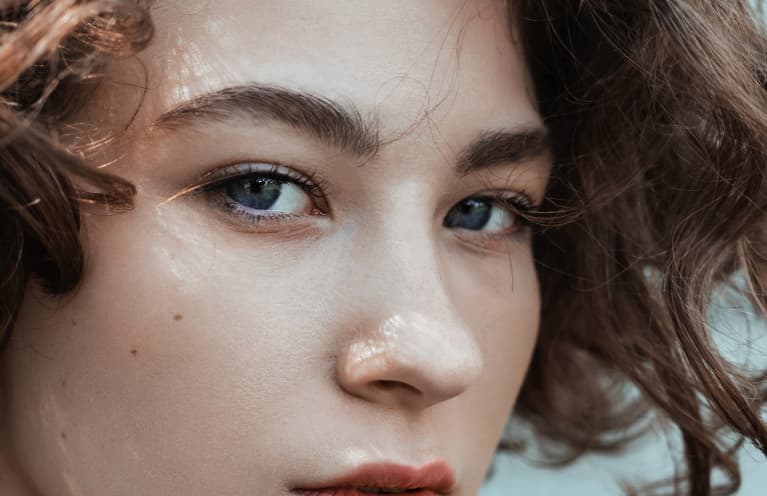
Our editors have independently chosen the products listed on this page. If you purchase something mentioned in this article, we may earn a small commission.
Your brows are made up of smaller, wispier strands, yet they’re privy to a bunch of hair and skin care woes: Your arches can experience shedding, graying, breakouts, and even dandruff—just, you know, on a way tinier scale. And if you regularly groom those face framers (with a wax, shave, thread, et al.), you may notice another pesky concern: eyebrow ingrowns.
However, because the skin around the eyes is so thin, you’ll want to treat ingrown brow hairs with extra care—you can’t expect to remove them like any other trapped hair on the face or body. Not to fear: Here, we tapped a brow expert for the best removal tips and how to prevent those bumps from making an appearance.
What causes eyebrow ingrowns?
You can get ingrowns anywhere you have hair follicles—including, yes, your eyebrows. Essentially, the wisps of hair can become trapped underneath the skin as it grows, which can result in a tiny, pimple-like mound. Ingrowns may happen more if you have coarse or curly brow hairs, says brow expert Joey Healy, but they’re super common, especially if you’re partial to a regular eyebrow wax or threading session.
“When you’re waxing or threading, you’re generalizing the direction of growth,” Healy adds, which can potentially break the hair. “When a hair breaks at the surface of the skin or right below, that’s a problem. You want to remove the hair in its entirety.”
And because the skin around the eyes is so sensitive, the bumps can be more painful than other types of ingrowns. “The hair quality in the brow is often a little bit coarser than, say, a hair on your arm,” adds Healy. That coarser hair plus sensitive skin is a perfect recipe for ingrowns, which is why they’re so common in the brow area.
Here, find Healy’s tips.
beauty & gut collagen+
A powerful daily ritual for glowing skin and strong hair & nails*

Tweezing is the most precise hair removal method, since you can pluck out one strand at a time and control the direction, so you can make sure you fully remove the hair without breaking it. Healy recommends snagging a pair of stainless steel slanted tweezers—like his Elite Sculpting Tweezer—to have even more accuracy and control. Now, that’s not to say you can never opt for a brow wax or thread; you might just want to opt for tweezer touch-ups if you can, especially if you’re susceptible to ingrowns.
2. Groom your brows after showering.
“Sometimes, people like to do their brows after they get out of the shower or after applying a warm compress to the brow, because it softens the area and opens the pore, making the hair removal a little bit easier,” Healy notes. This trick is particularly helpful during arid, wintry months, when the skin is more prone to dryness and flakes.
3. Follow up with an astringent.
If you frequently find yourself dealing with ingrowns, Healy says cleaning the area with a teeny bit of astringent can help tighten pores and reduce irritation. Soak a cotton swab with witch hazel (which has natural astringent properties) or diluted tea tree oil (which is antiseptic and antibacterial) and trace the brow area as the last step in your grooming routine. “If you feel like your skin is irritated after, [apply] aloe vera to soothe the skin and replenish the hydration,” he says.
4. Apply an ingrown treatment.
Prevention is everything when it comes to ingrown hairs, but some gentle exfoliation can treat them once they arrive. Select a product that includes chemical exfoliants, like salicylic acid and lactic acid, as well as hydrators like aloe vera to simultaneously soothe the skin. This Fur number should do the trick, or feel free to browse all of our favorite ingrown hair treatments. Whichever product you choose, apply for a few nights until the hair rises to the surface of the skin.
Ingrowns can be uncomfortable (especially on the sensitive brow skin), but it’s important not to mess with them before they’re ready; otherwise, you’ll only anger the irritation and inflammation, which may even lead to scarring. “Scarring is possible anytime we damage the skin,” Healy notes.
Rather, wait until the ingrown has broken through the skin—then, and only then, Healy says you can use a pointed tweezer to remove the hair. “You should do this only if it’s visible; if it’s not, you don’t want to go digging for it,” he adds. To be safe, you can always visit a brow technician or esthetician to remove the hair for you.
Got an eyebrow ingrown? Don’t grab the tweezers and go to town just yet—you want to be very careful with the sensitive brow area, as trying to extract the hair before its ready can result in even more inflammation. Try these tips, and make sure to care for freshly waxed or threaded brows to keep those ingrowns at bay in the first place.
Heal Your Skin.
Receive your FREE Doctor-Approved Beauty Guide
You are now subscribed
Be on the lookout for a welcome email in your inbox!
https://www.mindbodygreen.com/articles/eyebrow-ingrowns

